Curtin University NURS3003: Critique of Nursing Mental Health Article
VerifiedAdded on 2022/09/28
|6
|1824
|24
Report
AI Summary
This report provides a comprehensive critique of the research article by Lamont et al. (2017), which investigates mental health-related sickness absence among nurses and midwives. The critique evaluates the study's title, literature review, recruitment and sampling methods, data collection and analysis techniques, and ethical considerations. The report highlights the strengths of the study, such as its clear focus on key variables and appropriate sample size, while also pointing out weaknesses, including a lack of detail in ethical assurances and potential gaps in the methodology. The critique assesses the article's contribution to the understanding of workplace factors influencing nurses' mental health and offers suggestions for improvement, particularly concerning ethical safeguards and methodological clarity. The report also examines the study's findings, including the statistical analysis and the significance of the results. The report concludes by assessing the overall validity and reliability of the study, providing a well-rounded evaluation of the research article's impact and implications for healthcare practice.
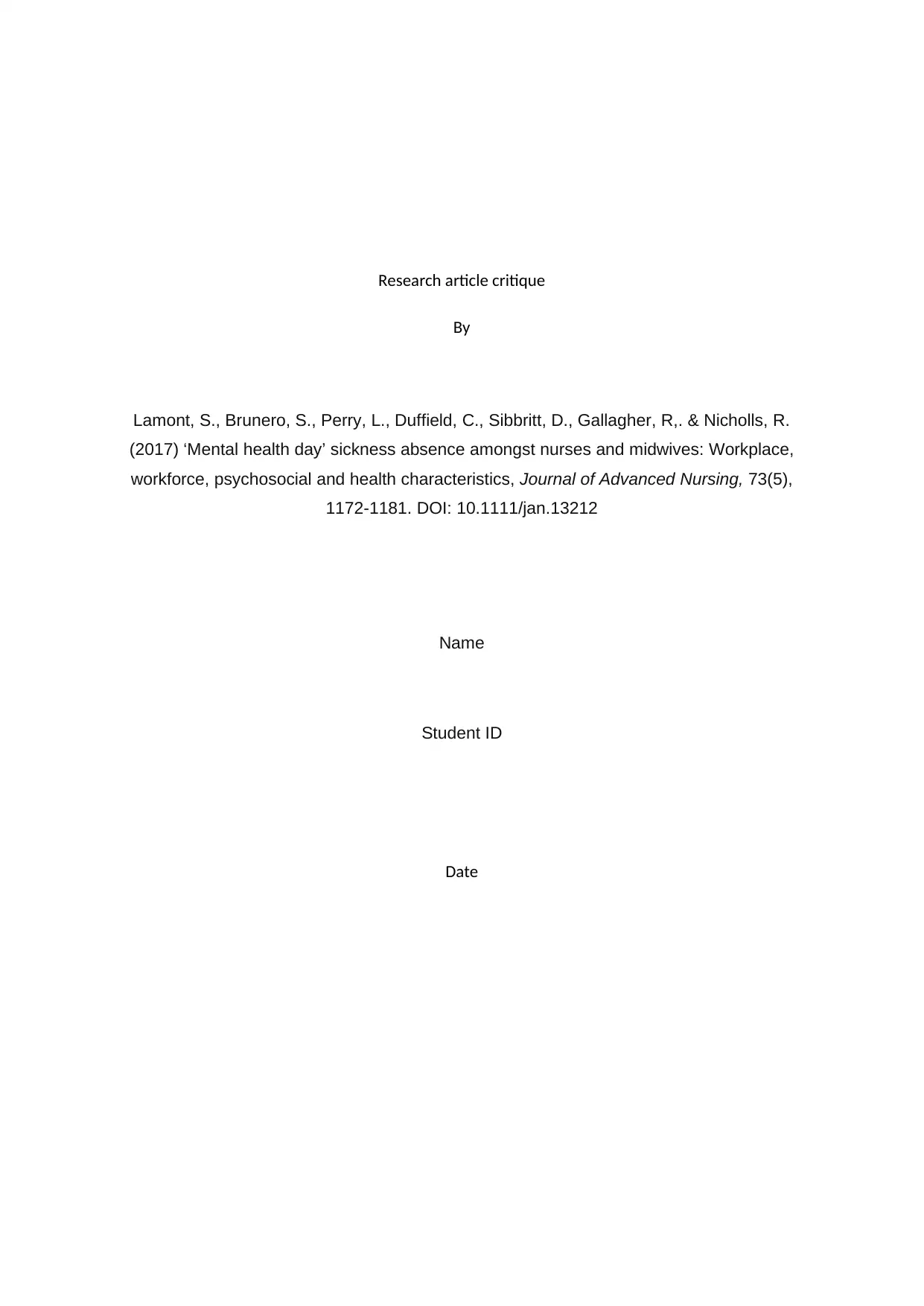
Research article critique
By
Lamont, S., Brunero, S., Perry, L., Duffield, C., Sibbritt, D., Gallagher, R,. & Nicholls, R.
(2017) ‘Mental health day’ sickness absence amongst nurses and midwives: Workplace,
workforce, psychosocial and health characteristics, Journal of Advanced Nursing, 73(5),
1172-1181. DOI: 10.1111/jan.13212
Name
Student ID
Date
By
Lamont, S., Brunero, S., Perry, L., Duffield, C., Sibbritt, D., Gallagher, R,. & Nicholls, R.
(2017) ‘Mental health day’ sickness absence amongst nurses and midwives: Workplace,
workforce, psychosocial and health characteristics, Journal of Advanced Nursing, 73(5),
1172-1181. DOI: 10.1111/jan.13212
Name
Student ID
Date
Paraphrase This Document
Need a fresh take? Get an instant paraphrase of this document with our AI Paraphraser
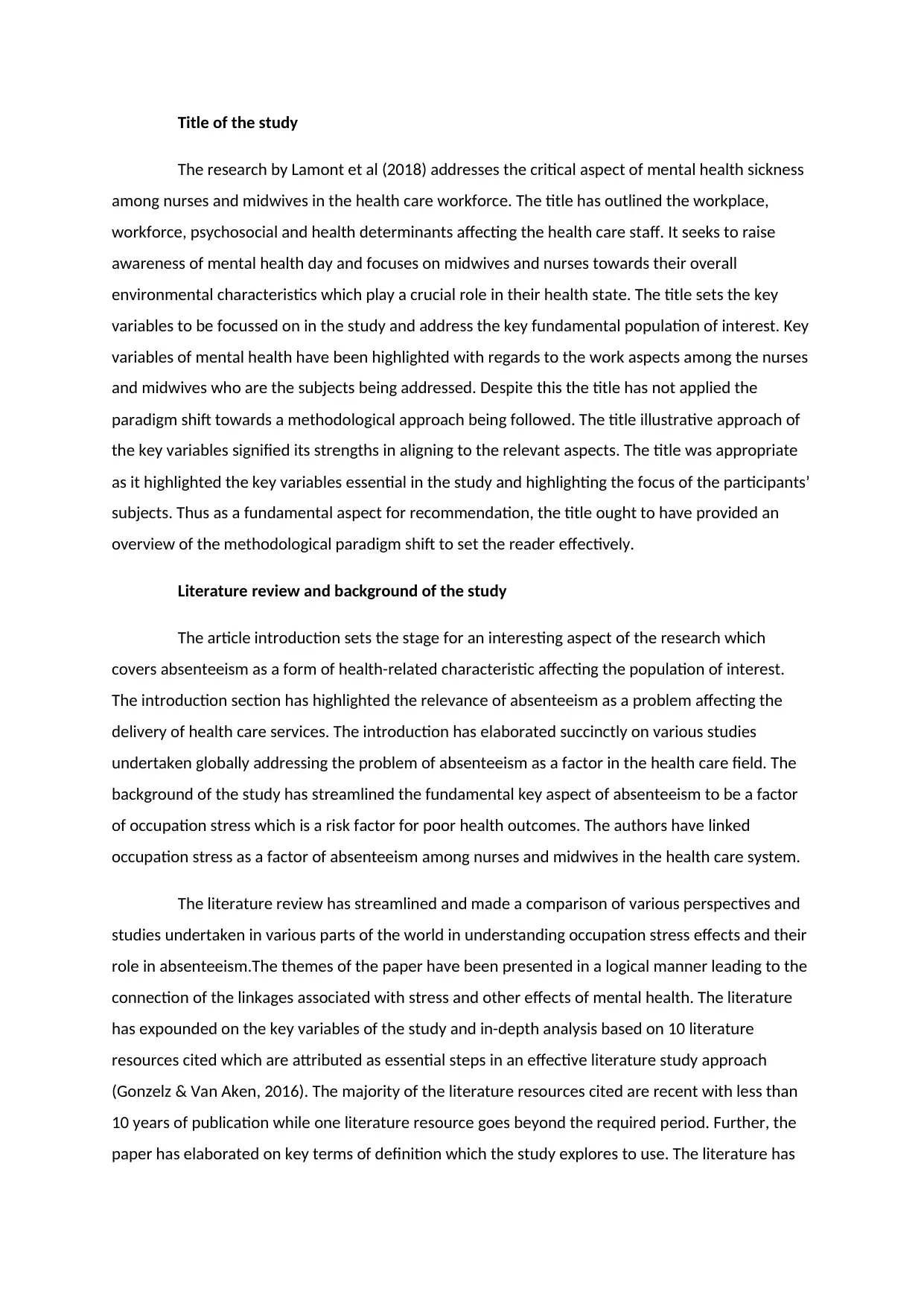
Title of the study
The research by Lamont et al (2018) addresses the critical aspect of mental health sickness
among nurses and midwives in the health care workforce. The title has outlined the workplace,
workforce, psychosocial and health determinants affecting the health care staff. It seeks to raise
awareness of mental health day and focuses on midwives and nurses towards their overall
environmental characteristics which play a crucial role in their health state. The title sets the key
variables to be focussed on in the study and address the key fundamental population of interest. Key
variables of mental health have been highlighted with regards to the work aspects among the nurses
and midwives who are the subjects being addressed. Despite this the title has not applied the
paradigm shift towards a methodological approach being followed. The title illustrative approach of
the key variables signified its strengths in aligning to the relevant aspects. The title was appropriate
as it highlighted the key variables essential in the study and highlighting the focus of the participants’
subjects. Thus as a fundamental aspect for recommendation, the title ought to have provided an
overview of the methodological paradigm shift to set the reader effectively.
Literature review and background of the study
The article introduction sets the stage for an interesting aspect of the research which
covers absenteeism as a form of health-related characteristic affecting the population of interest.
The introduction section has highlighted the relevance of absenteeism as a problem affecting the
delivery of health care services. The introduction has elaborated succinctly on various studies
undertaken globally addressing the problem of absenteeism as a factor in the health care field. The
background of the study has streamlined the fundamental key aspect of absenteeism to be a factor
of occupation stress which is a risk factor for poor health outcomes. The authors have linked
occupation stress as a factor of absenteeism among nurses and midwives in the health care system.
The literature review has streamlined and made a comparison of various perspectives and
studies undertaken in various parts of the world in understanding occupation stress effects and their
role in absenteeism.The themes of the paper have been presented in a logical manner leading to the
connection of the linkages associated with stress and other effects of mental health. The literature
has expounded on the key variables of the study and in-depth analysis based on 10 literature
resources cited which are attributed as essential steps in an effective literature study approach
(Gonzelz & Van Aken, 2016). The majority of the literature resources cited are recent with less than
10 years of publication while one literature resource goes beyond the required period. Further, the
paper has elaborated on key terms of definition which the study explores to use. The literature has
The research by Lamont et al (2018) addresses the critical aspect of mental health sickness
among nurses and midwives in the health care workforce. The title has outlined the workplace,
workforce, psychosocial and health determinants affecting the health care staff. It seeks to raise
awareness of mental health day and focuses on midwives and nurses towards their overall
environmental characteristics which play a crucial role in their health state. The title sets the key
variables to be focussed on in the study and address the key fundamental population of interest. Key
variables of mental health have been highlighted with regards to the work aspects among the nurses
and midwives who are the subjects being addressed. Despite this the title has not applied the
paradigm shift towards a methodological approach being followed. The title illustrative approach of
the key variables signified its strengths in aligning to the relevant aspects. The title was appropriate
as it highlighted the key variables essential in the study and highlighting the focus of the participants’
subjects. Thus as a fundamental aspect for recommendation, the title ought to have provided an
overview of the methodological paradigm shift to set the reader effectively.
Literature review and background of the study
The article introduction sets the stage for an interesting aspect of the research which
covers absenteeism as a form of health-related characteristic affecting the population of interest.
The introduction section has highlighted the relevance of absenteeism as a problem affecting the
delivery of health care services. The introduction has elaborated succinctly on various studies
undertaken globally addressing the problem of absenteeism as a factor in the health care field. The
background of the study has streamlined the fundamental key aspect of absenteeism to be a factor
of occupation stress which is a risk factor for poor health outcomes. The authors have linked
occupation stress as a factor of absenteeism among nurses and midwives in the health care system.
The literature review has streamlined and made a comparison of various perspectives and
studies undertaken in various parts of the world in understanding occupation stress effects and their
role in absenteeism.The themes of the paper have been presented in a logical manner leading to the
connection of the linkages associated with stress and other effects of mental health. The literature
has expounded on the key variables of the study and in-depth analysis based on 10 literature
resources cited which are attributed as essential steps in an effective literature study approach
(Gonzelz & Van Aken, 2016). The majority of the literature resources cited are recent with less than
10 years of publication while one literature resource goes beyond the required period. Further, the
paper has elaborated on key terms of definition which the study explores to use. The literature has
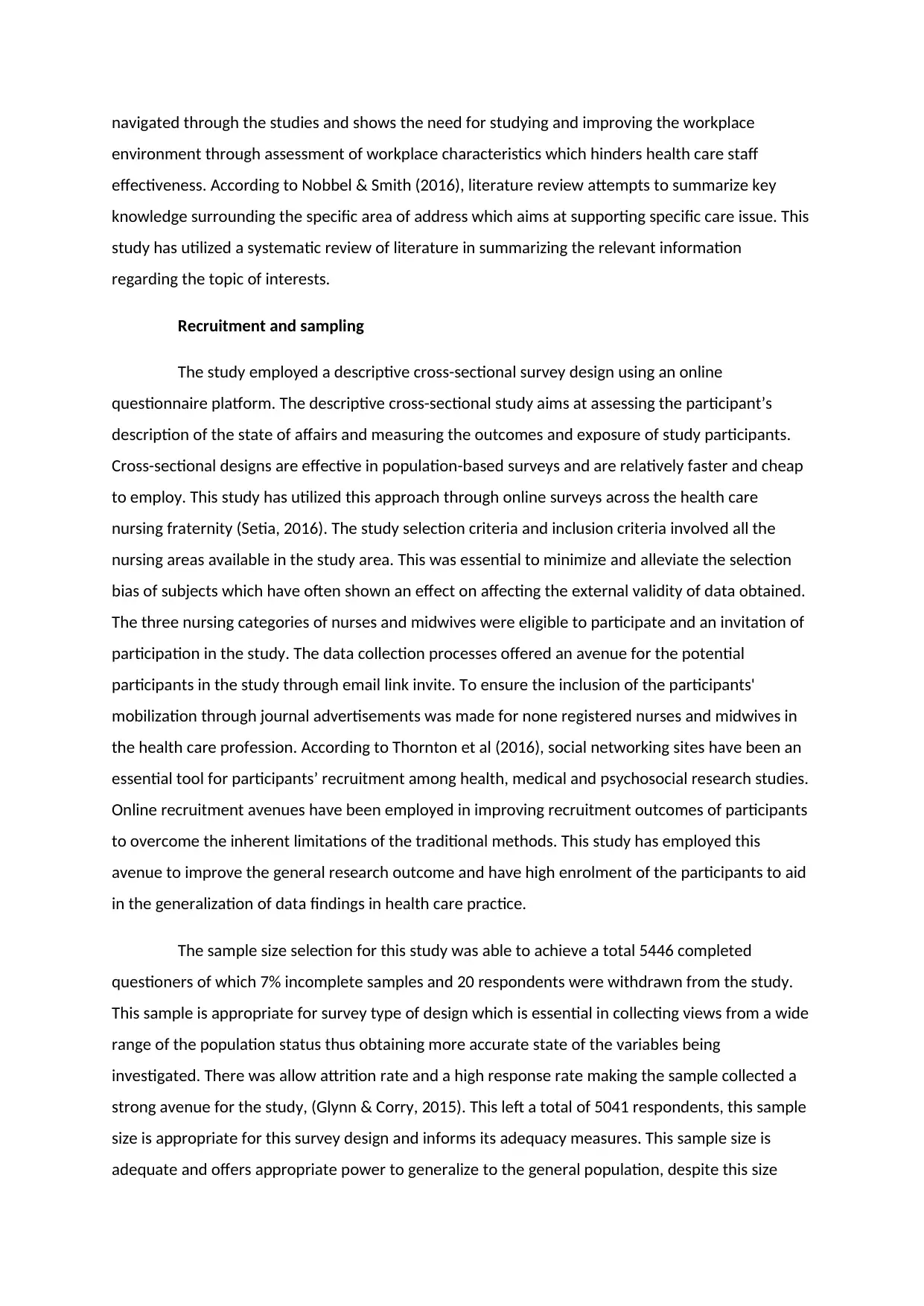
navigated through the studies and shows the need for studying and improving the workplace
environment through assessment of workplace characteristics which hinders health care staff
effectiveness. According to Nobbel & Smith (2016), literature review attempts to summarize key
knowledge surrounding the specific area of address which aims at supporting specific care issue. This
study has utilized a systematic review of literature in summarizing the relevant information
regarding the topic of interests.
Recruitment and sampling
The study employed a descriptive cross-sectional survey design using an online
questionnaire platform. The descriptive cross-sectional study aims at assessing the participant’s
description of the state of affairs and measuring the outcomes and exposure of study participants.
Cross-sectional designs are effective in population-based surveys and are relatively faster and cheap
to employ. This study has utilized this approach through online surveys across the health care
nursing fraternity (Setia, 2016). The study selection criteria and inclusion criteria involved all the
nursing areas available in the study area. This was essential to minimize and alleviate the selection
bias of subjects which have often shown an effect on affecting the external validity of data obtained.
The three nursing categories of nurses and midwives were eligible to participate and an invitation of
participation in the study. The data collection processes offered an avenue for the potential
participants in the study through email link invite. To ensure the inclusion of the participants'
mobilization through journal advertisements was made for none registered nurses and midwives in
the health care profession. According to Thornton et al (2016), social networking sites have been an
essential tool for participants’ recruitment among health, medical and psychosocial research studies.
Online recruitment avenues have been employed in improving recruitment outcomes of participants
to overcome the inherent limitations of the traditional methods. This study has employed this
avenue to improve the general research outcome and have high enrolment of the participants to aid
in the generalization of data findings in health care practice.
The sample size selection for this study was able to achieve a total 5446 completed
questioners of which 7% incomplete samples and 20 respondents were withdrawn from the study.
This sample is appropriate for survey type of design which is essential in collecting views from a wide
range of the population status thus obtaining more accurate state of the variables being
investigated. There was allow attrition rate and a high response rate making the sample collected a
strong avenue for the study, (Glynn & Corry, 2015). This left a total of 5041 respondents, this sample
size is appropriate for this survey design and informs its adequacy measures. This sample size is
adequate and offers appropriate power to generalize to the general population, despite this size
environment through assessment of workplace characteristics which hinders health care staff
effectiveness. According to Nobbel & Smith (2016), literature review attempts to summarize key
knowledge surrounding the specific area of address which aims at supporting specific care issue. This
study has utilized a systematic review of literature in summarizing the relevant information
regarding the topic of interests.
Recruitment and sampling
The study employed a descriptive cross-sectional survey design using an online
questionnaire platform. The descriptive cross-sectional study aims at assessing the participant’s
description of the state of affairs and measuring the outcomes and exposure of study participants.
Cross-sectional designs are effective in population-based surveys and are relatively faster and cheap
to employ. This study has utilized this approach through online surveys across the health care
nursing fraternity (Setia, 2016). The study selection criteria and inclusion criteria involved all the
nursing areas available in the study area. This was essential to minimize and alleviate the selection
bias of subjects which have often shown an effect on affecting the external validity of data obtained.
The three nursing categories of nurses and midwives were eligible to participate and an invitation of
participation in the study. The data collection processes offered an avenue for the potential
participants in the study through email link invite. To ensure the inclusion of the participants'
mobilization through journal advertisements was made for none registered nurses and midwives in
the health care profession. According to Thornton et al (2016), social networking sites have been an
essential tool for participants’ recruitment among health, medical and psychosocial research studies.
Online recruitment avenues have been employed in improving recruitment outcomes of participants
to overcome the inherent limitations of the traditional methods. This study has employed this
avenue to improve the general research outcome and have high enrolment of the participants to aid
in the generalization of data findings in health care practice.
The sample size selection for this study was able to achieve a total 5446 completed
questioners of which 7% incomplete samples and 20 respondents were withdrawn from the study.
This sample is appropriate for survey type of design which is essential in collecting views from a wide
range of the population status thus obtaining more accurate state of the variables being
investigated. There was allow attrition rate and a high response rate making the sample collected a
strong avenue for the study, (Glynn & Corry, 2015). This left a total of 5041 respondents, this sample
size is appropriate for this survey design and informs its adequacy measures. This sample size is
adequate and offers appropriate power to generalize to the general population, despite this size
⊘ This is a preview!⊘
Do you want full access?
Subscribe today to unlock all pages.

Trusted by 1+ million students worldwide
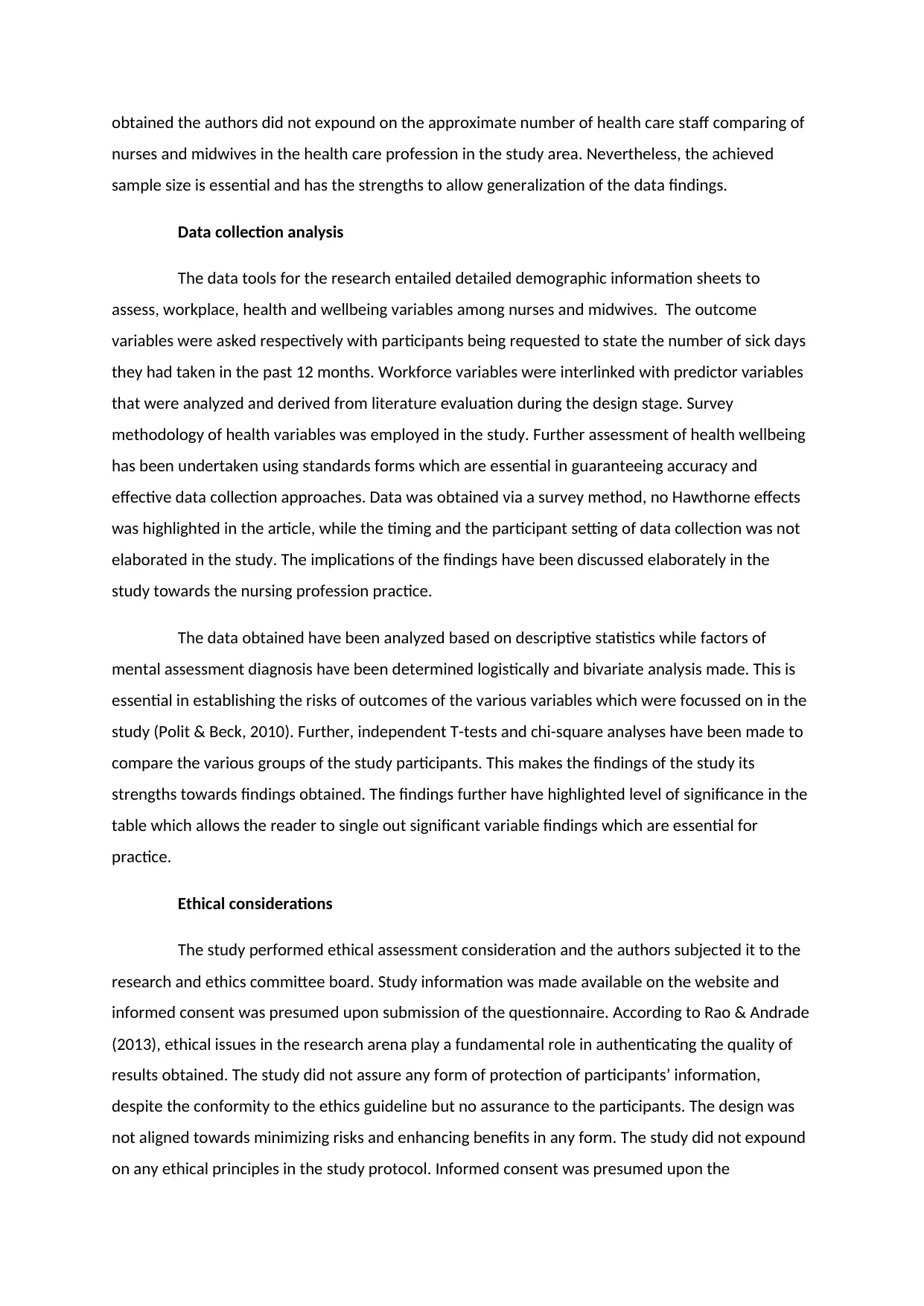
obtained the authors did not expound on the approximate number of health care staff comparing of
nurses and midwives in the health care profession in the study area. Nevertheless, the achieved
sample size is essential and has the strengths to allow generalization of the data findings.
Data collection analysis
The data tools for the research entailed detailed demographic information sheets to
assess, workplace, health and wellbeing variables among nurses and midwives. The outcome
variables were asked respectively with participants being requested to state the number of sick days
they had taken in the past 12 months. Workforce variables were interlinked with predictor variables
that were analyzed and derived from literature evaluation during the design stage. Survey
methodology of health variables was employed in the study. Further assessment of health wellbeing
has been undertaken using standards forms which are essential in guaranteeing accuracy and
effective data collection approaches. Data was obtained via a survey method, no Hawthorne effects
was highlighted in the article, while the timing and the participant setting of data collection was not
elaborated in the study. The implications of the findings have been discussed elaborately in the
study towards the nursing profession practice.
The data obtained have been analyzed based on descriptive statistics while factors of
mental assessment diagnosis have been determined logistically and bivariate analysis made. This is
essential in establishing the risks of outcomes of the various variables which were focussed on in the
study (Polit & Beck, 2010). Further, independent T-tests and chi-square analyses have been made to
compare the various groups of the study participants. This makes the findings of the study its
strengths towards findings obtained. The findings further have highlighted level of significance in the
table which allows the reader to single out significant variable findings which are essential for
practice.
Ethical considerations
The study performed ethical assessment consideration and the authors subjected it to the
research and ethics committee board. Study information was made available on the website and
informed consent was presumed upon submission of the questionnaire. According to Rao & Andrade
(2013), ethical issues in the research arena play a fundamental role in authenticating the quality of
results obtained. The study did not assure any form of protection of participants’ information,
despite the conformity to the ethics guideline but no assurance to the participants. The design was
not aligned towards minimizing risks and enhancing benefits in any form. The study did not expound
on any ethical principles in the study protocol. Informed consent was presumed upon the
nurses and midwives in the health care profession in the study area. Nevertheless, the achieved
sample size is essential and has the strengths to allow generalization of the data findings.
Data collection analysis
The data tools for the research entailed detailed demographic information sheets to
assess, workplace, health and wellbeing variables among nurses and midwives. The outcome
variables were asked respectively with participants being requested to state the number of sick days
they had taken in the past 12 months. Workforce variables were interlinked with predictor variables
that were analyzed and derived from literature evaluation during the design stage. Survey
methodology of health variables was employed in the study. Further assessment of health wellbeing
has been undertaken using standards forms which are essential in guaranteeing accuracy and
effective data collection approaches. Data was obtained via a survey method, no Hawthorne effects
was highlighted in the article, while the timing and the participant setting of data collection was not
elaborated in the study. The implications of the findings have been discussed elaborately in the
study towards the nursing profession practice.
The data obtained have been analyzed based on descriptive statistics while factors of
mental assessment diagnosis have been determined logistically and bivariate analysis made. This is
essential in establishing the risks of outcomes of the various variables which were focussed on in the
study (Polit & Beck, 2010). Further, independent T-tests and chi-square analyses have been made to
compare the various groups of the study participants. This makes the findings of the study its
strengths towards findings obtained. The findings further have highlighted level of significance in the
table which allows the reader to single out significant variable findings which are essential for
practice.
Ethical considerations
The study performed ethical assessment consideration and the authors subjected it to the
research and ethics committee board. Study information was made available on the website and
informed consent was presumed upon submission of the questionnaire. According to Rao & Andrade
(2013), ethical issues in the research arena play a fundamental role in authenticating the quality of
results obtained. The study did not assure any form of protection of participants’ information,
despite the conformity to the ethics guideline but no assurance to the participants. The design was
not aligned towards minimizing risks and enhancing benefits in any form. The study did not expound
on any ethical principles in the study protocol. Informed consent was presumed upon the
Paraphrase This Document
Need a fresh take? Get an instant paraphrase of this document with our AI Paraphraser
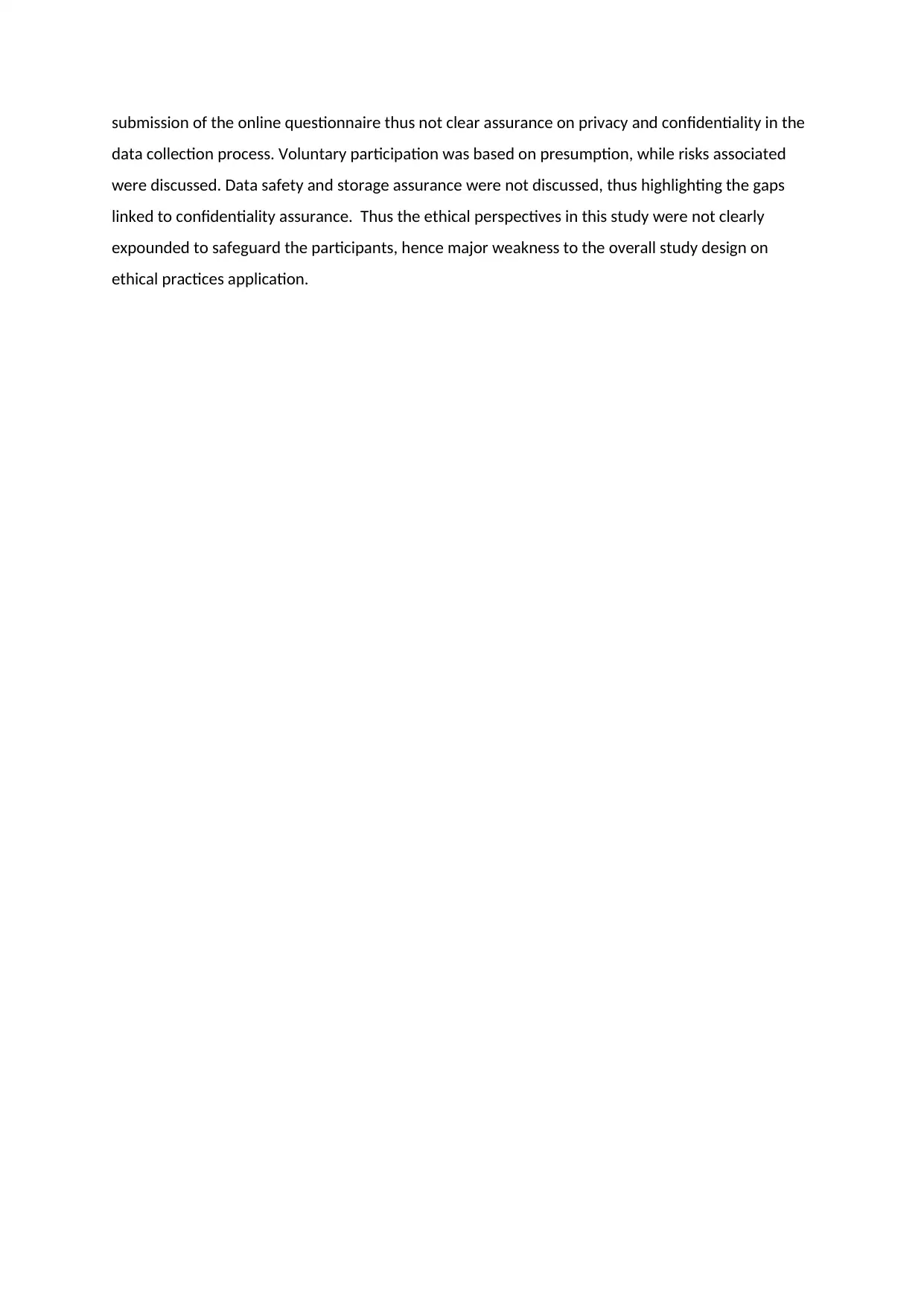
submission of the online questionnaire thus not clear assurance on privacy and confidentiality in the
data collection process. Voluntary participation was based on presumption, while risks associated
were discussed. Data safety and storage assurance were not discussed, thus highlighting the gaps
linked to confidentiality assurance. Thus the ethical perspectives in this study were not clearly
expounded to safeguard the participants, hence major weakness to the overall study design on
ethical practices application.
data collection process. Voluntary participation was based on presumption, while risks associated
were discussed. Data safety and storage assurance were not discussed, thus highlighting the gaps
linked to confidentiality assurance. Thus the ethical perspectives in this study were not clearly
expounded to safeguard the participants, hence major weakness to the overall study design on
ethical practices application.
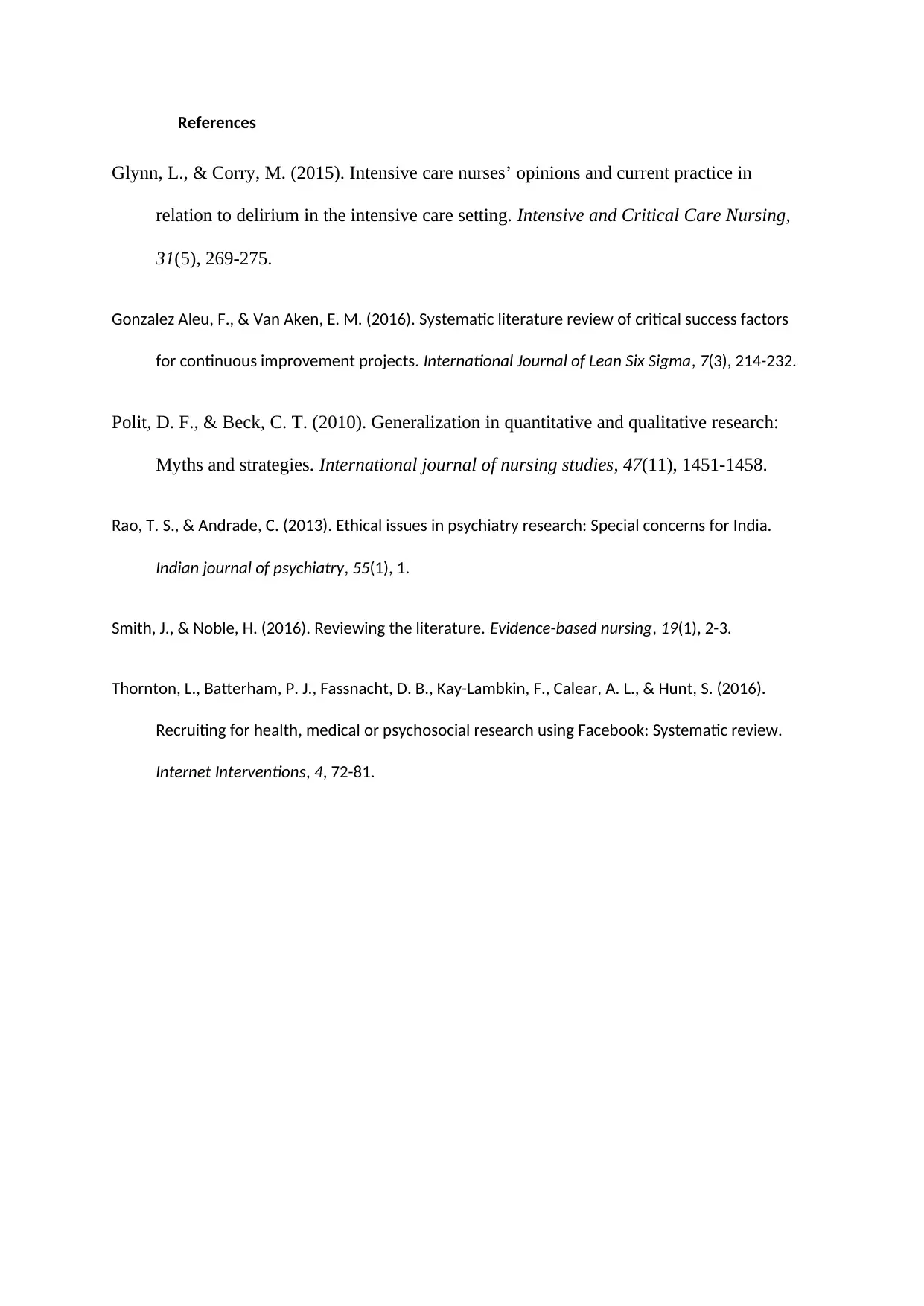
References
Glynn, L., & Corry, M. (2015). Intensive care nurses’ opinions and current practice in
relation to delirium in the intensive care setting. Intensive and Critical Care Nursing,
31(5), 269-275.
Gonzalez Aleu, F., & Van Aken, E. M. (2016). Systematic literature review of critical success factors
for continuous improvement projects. International Journal of Lean Six Sigma, 7(3), 214-232.
Polit, D. F., & Beck, C. T. (2010). Generalization in quantitative and qualitative research:
Myths and strategies. International journal of nursing studies, 47(11), 1451-1458.
Rao, T. S., & Andrade, C. (2013). Ethical issues in psychiatry research: Special concerns for India.
Indian journal of psychiatry, 55(1), 1.
Smith, J., & Noble, H. (2016). Reviewing the literature. Evidence-based nursing, 19(1), 2-3.
Thornton, L., Batterham, P. J., Fassnacht, D. B., Kay-Lambkin, F., Calear, A. L., & Hunt, S. (2016).
Recruiting for health, medical or psychosocial research using Facebook: Systematic review.
Internet Interventions, 4, 72-81.
Glynn, L., & Corry, M. (2015). Intensive care nurses’ opinions and current practice in
relation to delirium in the intensive care setting. Intensive and Critical Care Nursing,
31(5), 269-275.
Gonzalez Aleu, F., & Van Aken, E. M. (2016). Systematic literature review of critical success factors
for continuous improvement projects. International Journal of Lean Six Sigma, 7(3), 214-232.
Polit, D. F., & Beck, C. T. (2010). Generalization in quantitative and qualitative research:
Myths and strategies. International journal of nursing studies, 47(11), 1451-1458.
Rao, T. S., & Andrade, C. (2013). Ethical issues in psychiatry research: Special concerns for India.
Indian journal of psychiatry, 55(1), 1.
Smith, J., & Noble, H. (2016). Reviewing the literature. Evidence-based nursing, 19(1), 2-3.
Thornton, L., Batterham, P. J., Fassnacht, D. B., Kay-Lambkin, F., Calear, A. L., & Hunt, S. (2016).
Recruiting for health, medical or psychosocial research using Facebook: Systematic review.
Internet Interventions, 4, 72-81.
⊘ This is a preview!⊘
Do you want full access?
Subscribe today to unlock all pages.

Trusted by 1+ million students worldwide
1 out of 6
Your All-in-One AI-Powered Toolkit for Academic Success.
+13062052269
info@desklib.com
Available 24*7 on WhatsApp / Email
![[object Object]](/_next/static/media/star-bottom.7253800d.svg)
Unlock your academic potential
Copyright © 2020–2025 A2Z Services. All Rights Reserved. Developed and managed by ZUCOL.


